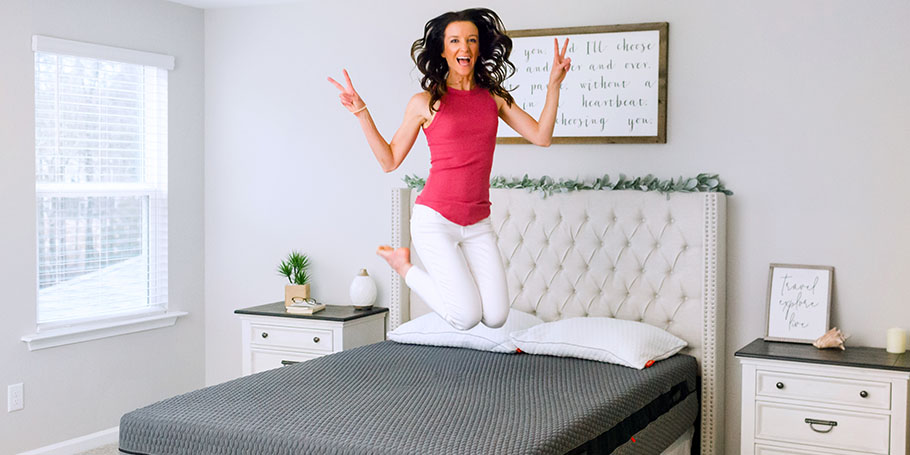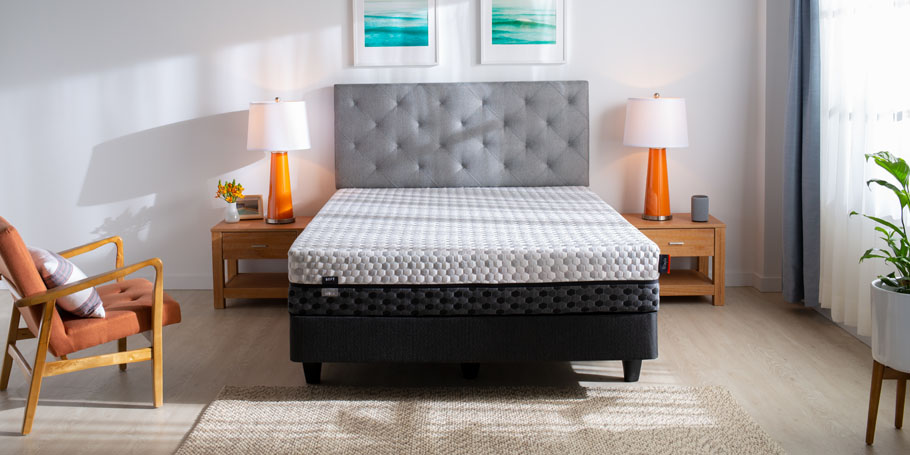Before you let doubt and buyer’s remorse take over your thoughts, you might need to give your new mattress some time to get used to its new home—this is called the mattress adjustment period. Adjusting to a new mattress can take time, especially if you’ve been sleeping on your old one for years. Throughout this post, we’ll go over how long it takes to adjust to a new mattress, some new mattress tips to make the adjustment period easier, and some FAQs. Keep reading to learn how to break in a new mattress as quickly and comfortably as possible.
- What Is an Adjustment Period?
- How Long Does It Take to Adjust to a New Mattress?
- Tips for a Successful Mattress Adjustment
- Mattress Adjustment FAQs
What Is an Adjustment Period?
A mattress adjustment period is the time it takes for your body to get used to a new mattress. Just like shoes, a new car, and baseball gloves, mattresses need a breaking-in period where the fibers and materials take time to loosen up.
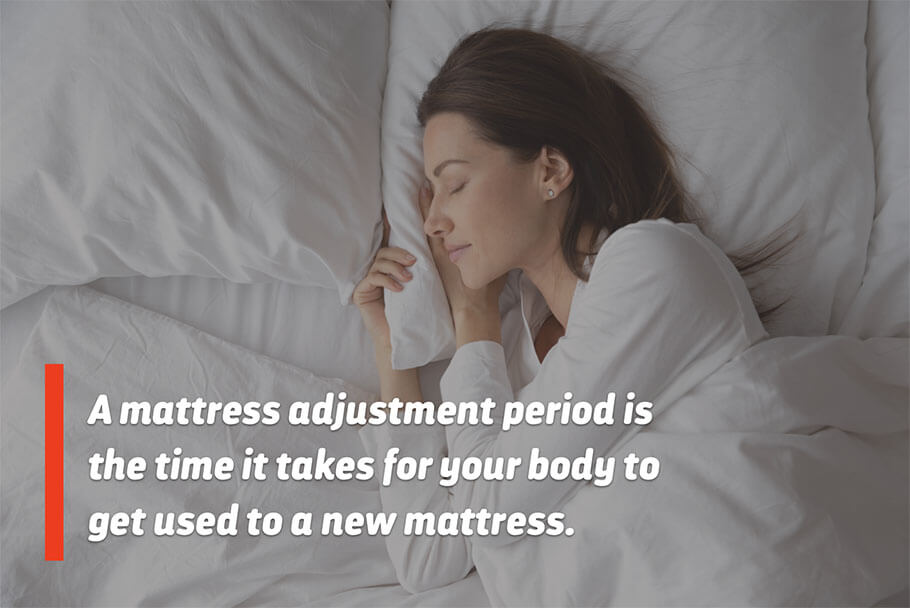
Let’s say you tested out a mattress in-store, marveling at how it felt like laying on a cloud. Once you make the purchase and it arrives at your home, you might realize it’s firm and stiff, making you wonder why the comfort level is so different. This is where you have to backtrack and think of all the people like you who have also tested out that same in-store mattress. After all those trial runs, the mattress took some time to break in and get used to people laying on it, meaning your new mattress will require the same patience.
How Long Does It Take to Adjust to a New Mattress?
It’s very common for new mattresses to feel firm and stiff upon arrival. Typically, it takes between 3 and 6 weeks to adjust to a new mattress. In most cases, your new mattress will be much different than your old one, especially since mattresses can last anywhere between 5 and 15 years, depending on the different types of mattresses.
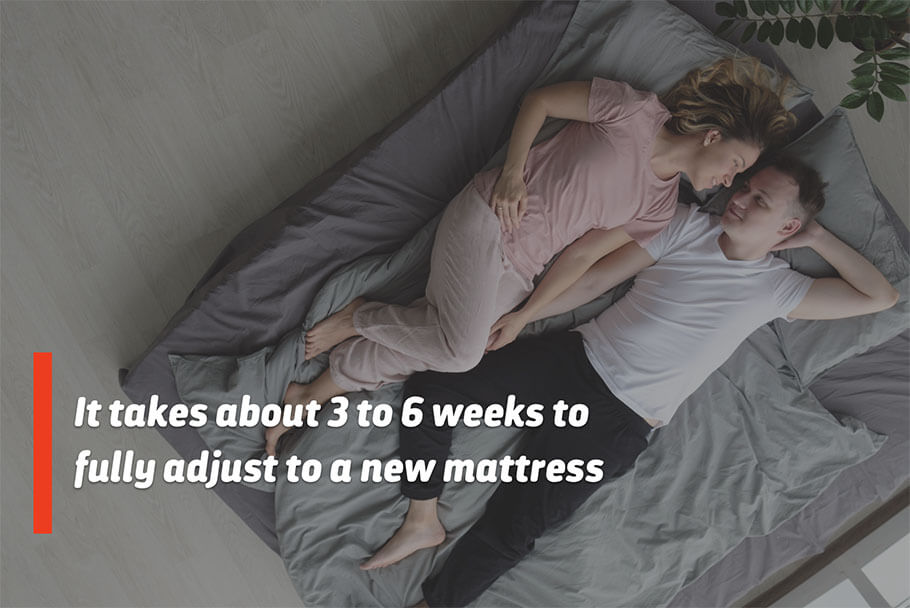
New mattresses also haven’t had the time to get used to your body and conform to its contours and weight. Think about your old mattress and all the bumps, lumps, indents, and springless springs. It’s important to remember that you’ve been sleeping on your old mattress for years, and your body adapted to its feel and comfort, which means it’ll take an adjustment period to fully embrace your body.
According to CNET.com, here are the adjustment periods for different types of mattresses:
- Memory foam mattress: 60 days
- Innerspring mattress: 30 days
- Latex foam mattress: 2 to 14 days
Depending on the quality of materials for each type of mattress, the break-in period might be longer or shorter, and can also depend on personal preference.
Tips for a Successful Mattress Adjustment
You finally bought your dream mattress, and you can’t wait to put it to good use. Before you dive under the covers expecting a perfect sleep, let’s go over some new mattress tips to help with a successful mattress adjustment. Below are a few ways you can easily acclimate to your new mattress, according to Sleep Advisor:
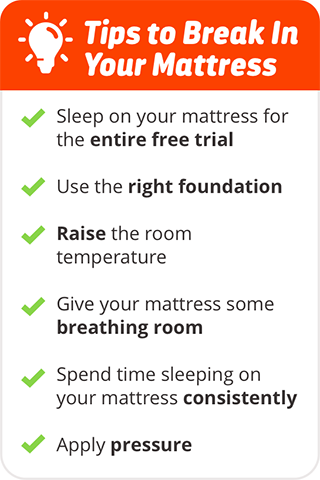
- Sleep on your mattress for the entire free trial: Most mattress companies offer their customers a free trial to test out their new mattress. At Layla Sleep, you can try any of our mattresses for 120 nights, and if you’re not satisfied, we’ll pick it up for free and give you your refund. No matter the brand you choose, it’s important to sleep on it for the full free trial period. This way, you can adjust to the new mattress without the fear of losing your money if you’re unsatisfied.
- Use the right foundation: The foundation is just as important as the mattress itself. If you have a broken, sagging, or wrong-sized foundation, your mattress will have a tough time adjusting. At Layla Sleep, you can choose between our mattress foundation and bed frame, adjustable base, metal platform base, and platform base.
- Raise the room temperature: Believe it or not, your room’s temperature can help break in your new mattress. If you purchase a memory foam mattress, raising the temperature can help the memory foam become softer and more responsive. While a warm bedroom can disrupt your sleep, it can help speed up your mattress adjustment period if you’re in a hurry.
- Give your mattress some breathing room: Today, around 36% of shoppers buy their mattress online, with 43% of Millennials choosing online delivery compared to 26% of Boomers, according to the International Sleep Products Association. With that said, it’s important to give your mattress some time to breathe. This is because your mattress might have an off-gassing smell and was tightly packed in a box or rolled up. According to SleepingReport.com, off-gassing is the release of VOCs during unwrapping, which can cause odors, but isn’t harmful to humans. Even if you bought your mattress in-store, you should still let your mattress breathe for a few days, as it was most likely wrapped in plastic or boxed up.

- Spend time sleeping on your mattress consistently: One of the easiest ways to break in your new mattress is to sleep on it consistently. You may not like the idea of having to sleep on a new mattress that’ll leave you tossing and turning, but over time, consistent use can help break your mattress in faster.
- Apply pressure: Applying pressure to your new mattress is another easy way to break it in. By applying pressure, you’ll be able to loosen up the materials, expediting the time it takes for your mattress to conform to your body. To apply pressure, gently walk over your mattress, or crawl over it using your hands and knees. If these options don’t sound comfortable, you can place heavy objects on your bed, such as books.
Your mattress adjustment period will take some time, so it’s important to be patient and allow your bed to get used to being in its new home. With these new mattress tips, you’ll be adjusting to a new mattress in no time.
Mattress Adjustment FAQs
What if My Mattress Never Breaks In?
Some eager sleepers might think their mattress isn’t adjusting properly. If you think your mattress isn’t breaking in, it’s important to give it some time and wait. Typically, your mattress will break in over time, which is why it’s important to wait until you near your free trial end date. If you continue having trouble adjusting to your new mattress, there’s the possibility of a manufacturing defect, or your body might not agree with the mattress material. In this case, you can exchange for a new mattress or return it and find a new sleeping surface.
How Can I Speed Up the Mattress Adjustment Period?
Tossing and turning is never fun, and you may be wondering how to speed up the mattress adjustment period. As stated, time will always be your best friend when it comes to adjusting to your new mattress. However, some new mattress tips for breaking it in easier include raising your bedroom’s temperature, applying pressure by walking over it, allowing it to breathe, and spending as much time as possible sleeping on the mattress. At the end of the day, the more you sleep on your new mattress, the faster you’ll get used to the new feel and comfort, and the faster the mattress materials will loosen up and adjust to your body.
How Often Should I Replace My Mattress?
A common question many people have is how often to replace a mattress. In general, it’s recommended to replace your mattress every 6 to 8 years. However, the type of mattress you have can change the frequency of replacing your mattress. For example, memory foam and hybrid mattresses can last up to 10 years, latex mattresses can last up to 15 years, and innerspring mattresses can last up to 8 years.
Is It Normal for a New Mattress to Cause Pain?
When you first sleep on a new mattress, it might not be as comfortable as your old mattress. This is because the mattress might be too firm, which can cause some discomfort, such as neck, shoulder, and back pain. Any pain can also be a result of your sleeping position, lifestyle, or other factors. However, if the pain comes after you begin sleeping on a new mattress and it continues throughout the adjustment period, it might be a sign you need a different mattress. If firmness is becoming an issue, Layla Sleep’s mattresses come with Flippable Firmness™, so that you can enjoy a soft side or a firm side.

